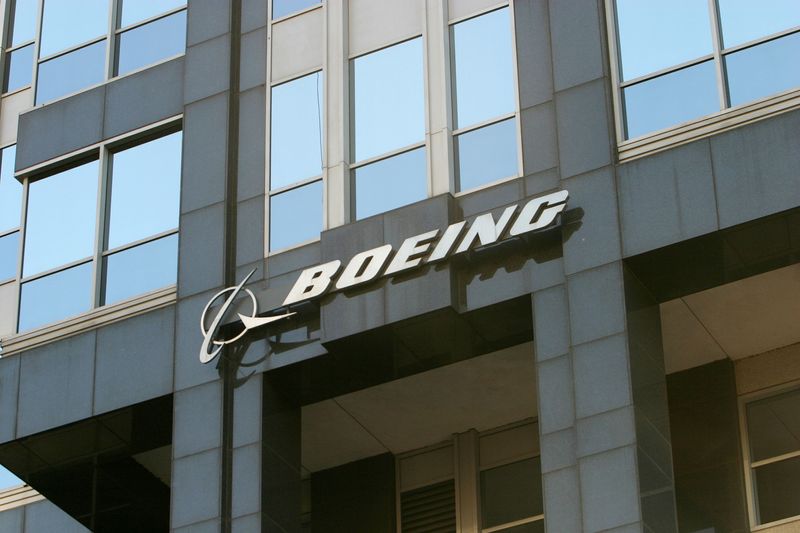WASHINGTON/SEATTLE (Reuters) -Boeing Co said on Thursday it will move its headquarters from Chicago to Arlington, Virginia, as the crisis-plagued U.S. planemaker works to repair relationships with customers, federal regulators and lawmakers.
Boeing also plans to develop a research and technology hub in the Arlington area, home to the Pentagon and across the Potomac River from the U.S. capital.
Senator Mark Warner of Virginia told Reuters in an interview the headquarters move “is great for bragging rights — what maybe a long-term bigger boost to (Virginia) may be the research and development center.”
Last October, Reuters reported that sources close to the company said cost cuts and a more hands-on corporate culture had raised questions about Boeing’s future in Chicago, and in turn the broad direction Boeing intends to take as it tries to regain its stride.
“The region makes strategic sense for our global headquarters given its proximity to our customers and stakeholders, and its access to world-class engineering and technical talent,” Boeing President and Chief Executive Officer Dave Calhoun said.
Boeing said it will maintain a significant presence at its Chicago location and surrounding region. Mayor Lori Lightfoot said Chicago has “a robust pipeline of major corporate relocations and expansions, and we expect more announcements in the coming months.”
Boeing has been working to repair its relationship with the U.S. Federal Aviation Administration (FAA) and lawmakers. Prior CEO Dennis Muilenburg was fired in 2019 after clashing with the FAA over its review of the 737 MAX following two fatal crashes that killed 346 people.
Boeing, a key supplier to the U.S. Defense Department, last week unveiled more than $1 billion in charges on its Air Force One and T-7A Red Hawk trainer jet programs.
Boeing already has an Arlington office that opened in 2014 and has significant unused space, blocks from Amazon.com Inc’s HQ2 building that is under construction.
Boeing shares closed down 4.1% as U.S. stocks broadly fell sharply.
The Chicago headquarters – a 36-floor, $200 million riverfront skyscraper – has also been at the crossroads of a cost-cutting campaign for Boeing which has shed real estate, including its commercial airplane headquarters in Seattle.
Boeing moved its headquarters to Chicago in 2001, leaving its Seattle home after 85 years following its 1997 merger with St. Louis-based rival McDonnell Douglas. That move angered rank-and-file mechanics and engineers.
Boeing was seeking a post-merger headquarters in a neutral location separate from those existing divisional power centers.
Chicago, Cook County and Illinois awarded Boeing more than $60 million in tax and other incentives over 20 years to relocate. Those credits have expired, though Boeing was set to receive 2021 funds this year.
House of Representatives Transportation Committee Chair Peter DeFazio blasted Boeing’s decision to move to Arlington.
“Moving their headquarters to Chicago and away from their roots in the Pacific Northwest was a tragic mistake,” DeFazio said. “Moving their headquarters again, this time to be closer to the federal regulators and policymakers in Washington, D.C. is another step in the wrong direction. Boeing’s problem isn’t a lack of access to government, but rather its ongoing production problems and the failures of management and the board that led to the fatal crashes of the 737 MAX.”
Some critics viewed the Chicago move as indicating that Boeing prized near-term profits over long-term engineering dominance. After the two fatal 737 MAX crashes, Boeing’s imperative became prowess and repairing relationships with customers and regulators.
Calhoun has made repeated trips to its 787 Dreamliner factory in South Carolina to deal with production-related defects and certification delays that have hobbled the program.
Calhoun is also working to win FAA certification by year end of the largest model of the 737 MAX. If not, he hopes Congress will grant an extension for the MAX 10 or else the plane would need to meet a safety standard on cockpit alerts.
The deadline for changes was mandated by Congress in late 2020 as part of regulatory reforms at the FAA following the fatal crashes.
(Reporting by Eric M. Johnson in Seattle and David Shepardson in Washington; Editing by Will Dunham and David Gregorio)
























